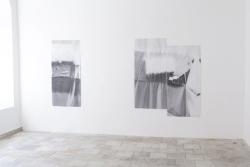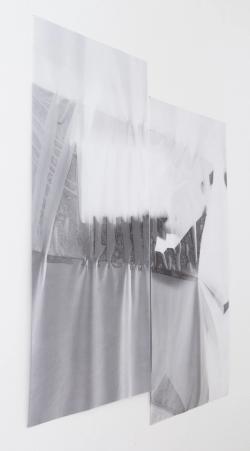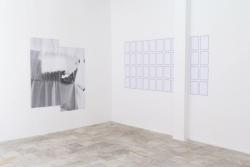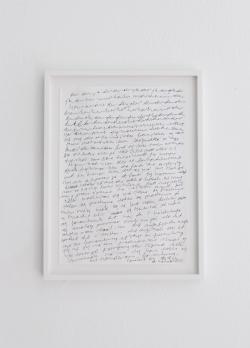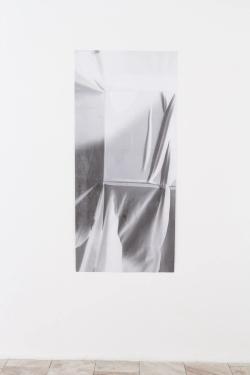Martine Flor
Echoes From A Scene
26.06. – 18.07.2021' /%3E%3C/svg%3E)
Echoes From a Scene, 2021 Installation view ' /%3E%3C/svg%3E)
Echoes From a Scene I, 2021 Part of a series of three works 150x68cm / Spatial photogram on Polyester ' /%3E%3C/svg%3E)
Echoes From a Scene I, 2021 Detail 150x68cm / Spatial photogram on Polyester ' /%3E%3C/svg%3E)
Echoes From a Scene II, 2021 Part of a series of three works 150x68cm / Spatial photogram on Polyester ' /%3E%3C/svg%3E)
Echoes From a Scene II, 2021 Part of a series of three works 150x68cm / Spatial photogram on Polyester ' /%3E%3C/svg%3E)
Echoes From a Scene, 2021 Installation view ' /%3E%3C/svg%3E)
On Archetypal Longing, 2021 117x236cm / 40 sheets of paper ' /%3E%3C/svg%3E)
Echoes From a Scene, 2021 Installation view ' /%3E%3C/svg%3E)
Index of Synchrony 2020.03.06, 2021 Part of a larger series 33,5x33cm / Page cut from notebook, framed ' /%3E%3C/svg%3E)
Echoes From a Scene III, 2021 Part of a series of three works 150x68cm / Spatial photogram on Polyester
The Shroud of Turin is probably the most famous piece of fabric in Italy. It is said to have been wrapped around the body of Jesus at his burial. This fragile piece of linen carries faint marks that resemble a naked human with crossed arms and a peaceful face. It is sensitive to light and air, and only shown on very rare occasions behind bullet-proof glass. From its first mention in the 14th century until today the Shroud of Turin travels like a bullet through the history of images. First, we have the many depictions of the shroud within Christian art. Then the famous photograph by Pia Secondo in 1898, which rendered the face of a man visible in the negative. The actual cloth is an image in itself and has within the study of signs during the 20th century been said to have the same indexical relationship to the thing depicted as a photograph. As an unexpected development, the photograph by Secondo was turned into an icon by the devotion of the Holy Face. Miraculously they say the image of the face was made without hand(acheiropoieta).
As an instance within the history of images, Martine Flor's exhibition at Heerz Tooya seems to be pierced by this shrouded bullet. It revolves around the series of works called Echoes From A Scene, which is also the title of the exhibition. Flor's remarkable photogram technique used for the series brings the camera-less photography by surrealists such as Man Ray to mind, where the distance between subject matter and the capturing medium is abolished. They both operate through contact, but instead of distinct objects arranged on a flat surface, Flor’s technique embraces spatial configurations that are then turned into the flatness that characterises an image. The result prompts the question: How ephemeral can touch be to still leave a mark?
Index of Synchrony (2020.03.06), 2021 is an attempt to exhaust language and text to a point where the body, matter and thought unite into a single breath. The line travels over the paper in an unruly pace, it moves forward, skips to the next row and continues as if stopping was impossible. At times it reaches a state of smooth musicality, reminiscent of the weightlessness of Echoes From a Scene I-III, 2021. The force that is driving the movement aims at its own dissolution and to the acheiropoietic. The traces stay, they bear testimony of the event and of a motion in time, but the hand gradually withdraws. How much pressure is needed to inscribe memory into matter?
The body wrapped in the piece of fabric is gone and the blood that seeped out to leave a stain has now dried up. The face smudged onto the cloth is barely there, and to prevent its feared annihilation and the loss of memory it is copied and multiplied. The Bulgarian tradition of obituaries with photographed portraits hanging outside the houses of the deceased manifests a similar wish. By continuously renewing the posters, the mourners suspend the second death by keeping the memory alive. However, in On Archetypal Longing, 2021, which departs from this tradition, the posters are faceless. Being 40 in number, they allude to the days just after death when the soul still drifts among us, and by tradition no images should be displayed. With the repetition of empty posters plastered on the gallery walls we are left with the possibility of a memory without a face, or perhaps an icon that does not leave the faintest mark.
Charles Sanders Peirce, famous within the study of signs, once compared an index to a bullet-hole. For him a bullet-hole would always be a sign of a shot, and anyone who begged to differ would be wrong. The bullet-proof glass in front of the shroud denies this principle. Surely, a fired gun would leave a mark, but it would also tell us much more than that there had been a shot. The glass in itself, already demonstrates this clearly despite its transparency. It belongs to the same realm of transparent signs which Martine Flor takes us to. As with the shroud, they are on the brink of dissolution, yet carry a solid drive. This is how a scene is created. -Elias Kautsky
Martine Flor (b.1989, Norway) lives and works in Sweden where she holds an MFA from Malmö Art Academy (2018). In 2017 she did an exchange at Akademie der Bildende Künste Vienna (Textual Sculpture, prof. Heimo Zobernig) and in 2016 she was a guest student at Escola Maumaus in Lisbon. She has exhibited at Obra Gallery in Malmö, Malmö Art Museum, Trøndelag Center for Contemporary Art, among other places. In 2019 she assisted artist Mary Kelly in Los Angeles and this fall she will attend the Whitney Independent Study Program in New York.
Торинската плащеница е вероятно най-известният къс плат в Италия. Казват, че е бил увит около тялото на Исус при неговото погребение. Този нежен къс сукно носи бледи отпечатъци, които наподобяват голо човешко тяло с кръстосани ръце и умиротворено лице. Чувствително е на светлина и въздух, и бива показвано пред публика в много редки случаи, зад бронирано стъкло. От първия момент, когато става въпрос за него през 14 век до днес, Торинската плащеница преминава като куршум през историята на изображенията. Първо, това са многобройните описания на плащеницата в християнското изкуство. След това е известната фотография на Пиа Секондо от 1898 г., която показва лицето на мъж в негатива. Сам по себе си, платът е изображение и с изучаването на знаците през 20 век, се смята, че има същото индекскно отношение към изобразения обект, като фотография. Като неочакван развой, фотографията на Секондо се превръща в икона на преклонение пред Светия Образ. По чудо казват, че изображението не е от човешка ръка (неръкотворно).
Като още един пример в историята на изображенията, изложбата на Мартин Флор в Галерия Хеерц Тооя, сякаш е пронизана от този забулен в сукно куршум. Тя се разгръща около серия произведения, наречена„Отзвуци от гледка”, което е и заглавието на самата изложба. Забележителната фотограмска техника използвана от Флор за серията ни напомня за фотографията на сюрреалисти като Ман Рей, при която не е използвана фотокамера и е премахната дистанцията между обект на изображение и среда, която го улавя. И двамата работят чрез допира, но вместо отделни предмети аранжирани върху плоска повърхност, техниката на Флор обхваща простраствени конфигурации, които след това са превърнати в плоско изображение. Резултатът подтиква към въпроса: колко ефимерно е докосването, което все пак оставя отпечатък?
„Индекс на синхрония І” (Index of Synchrony I (2020.03.06)), 2021 г.е опит за изчерпване на език и текст до момента, в който тяло, материя и мисъл се слеят в един единствен дъх. Линията преминава по хартията с непокорен ход, отива напред, прескача към следващия ред и продължава, сякаш е невъзможно да спре. На моменти стига до състояние на гладка музикалност, напомняща безтегловността на „Отзвуци от гледка І-ІІІ” (Echoes From a Scene I-III), 2021 г. Силата стимулираща това движение цели своето собствено разтапяне/разтваряне и неръкотворност. Следите остават; те носят доказателство за събитие и движение във времето, но ръката постепенно се отдръпва. Колко натиск е необохдим, за да се отпечата споменът в материята?
Тялото, увито в онзи къс сукно вече го няма и кръвта, просмукала се и оставила петна, е изсъхнала. Лицето размазано върху сукното е едва доловимо, а за да се предотврати неговото плашещо унищожаване и забрава, то е копирано и размножавано. Българската традиция на поставяне на некролози със снимки по фасадите на къщите на починалите е израз на същото желание. С постоянното подновяване на тези некролози, опечалените поддържат втората смърт, като пазят спомена жив. Все пак обаче, в „За архитипния копнеж” (On Archetypal Longing), 2021 г., който тръгва от тази традиция, постерите са без лица. 40 на брой, те загатват за дните непосредствено след смъртта, когато душата все още витае между нас и по традиция не трябва да се поставят изображения. Повторящите се празни постери облепили стените на галерията ни оставят възможността за спомен без лице, или може би икона, от която не остава и бледа следа.
Чарлс Сандърс Пърс, известен в областта на изследване на знаците, някога сравни индекса с дупка от куршум. За него дупката от куршум винаги е била знак за изстрел и всеки, който твърди обратното, греши. Бронираното стъкло пред плащеницата отхвърля този принцип. Със сигурност, изстрел от оръжие ще остави отпечатък, но този отпечатък ще ни каже много повече от това, че е имало изстрел. Стъклото само по себе си вече ясно го показва, въпреки своята прозрачност. То принадлежи към същото царство на прозрачни знаци, в което ни отвежда Мартин Флор. Както и с плащеницата, те всеки момент ще се разтворят и изчезнат, но все пак носят силен заряд. Ето така се създава гледка. - Елиас Каутски
The exhibition is supported by the Norwegian Art Council. Bulgarian translation by Militsa Ganchev.
